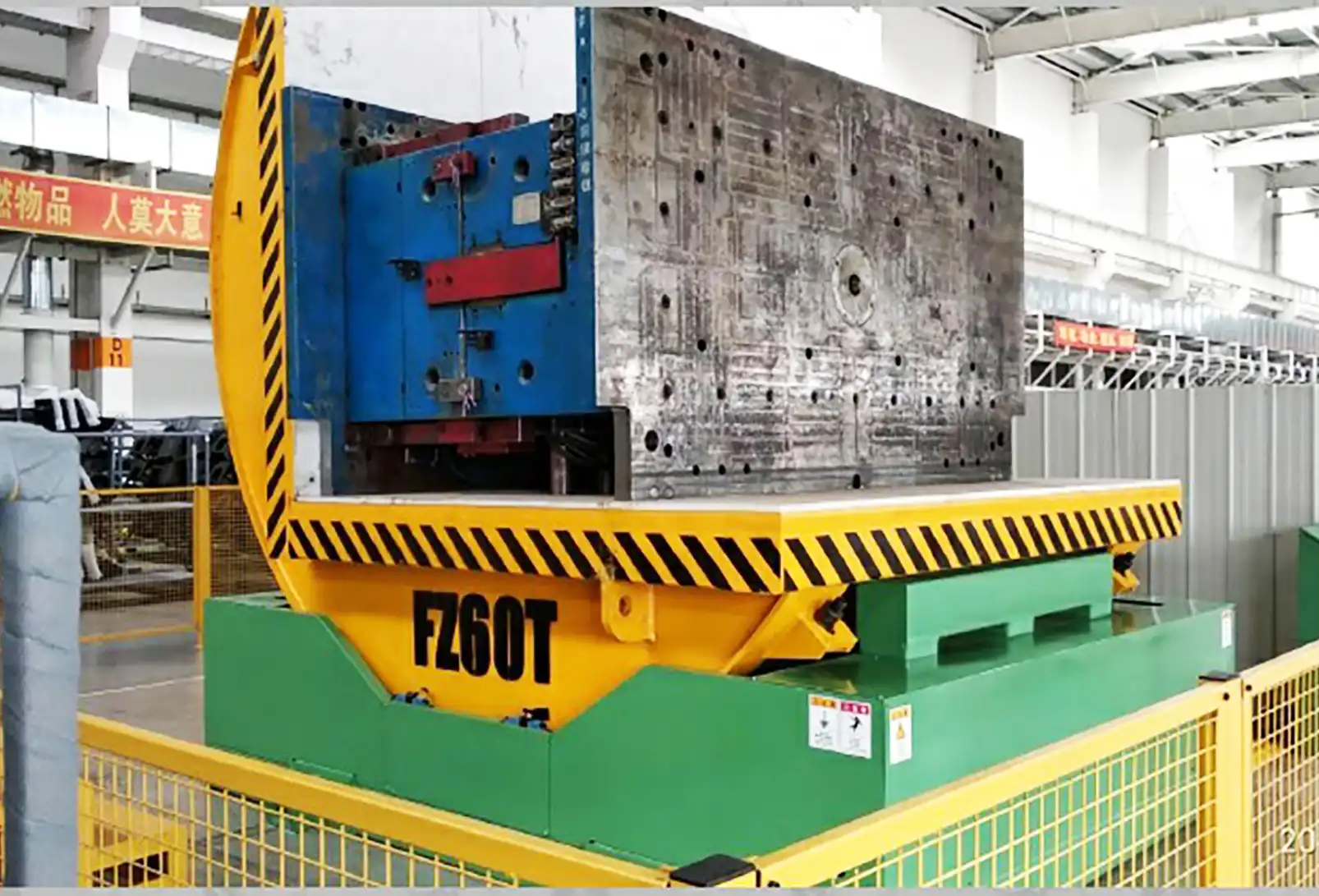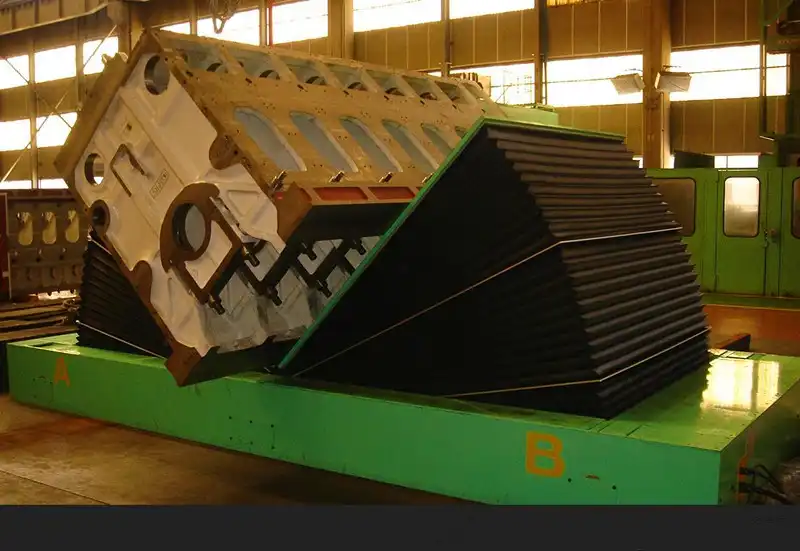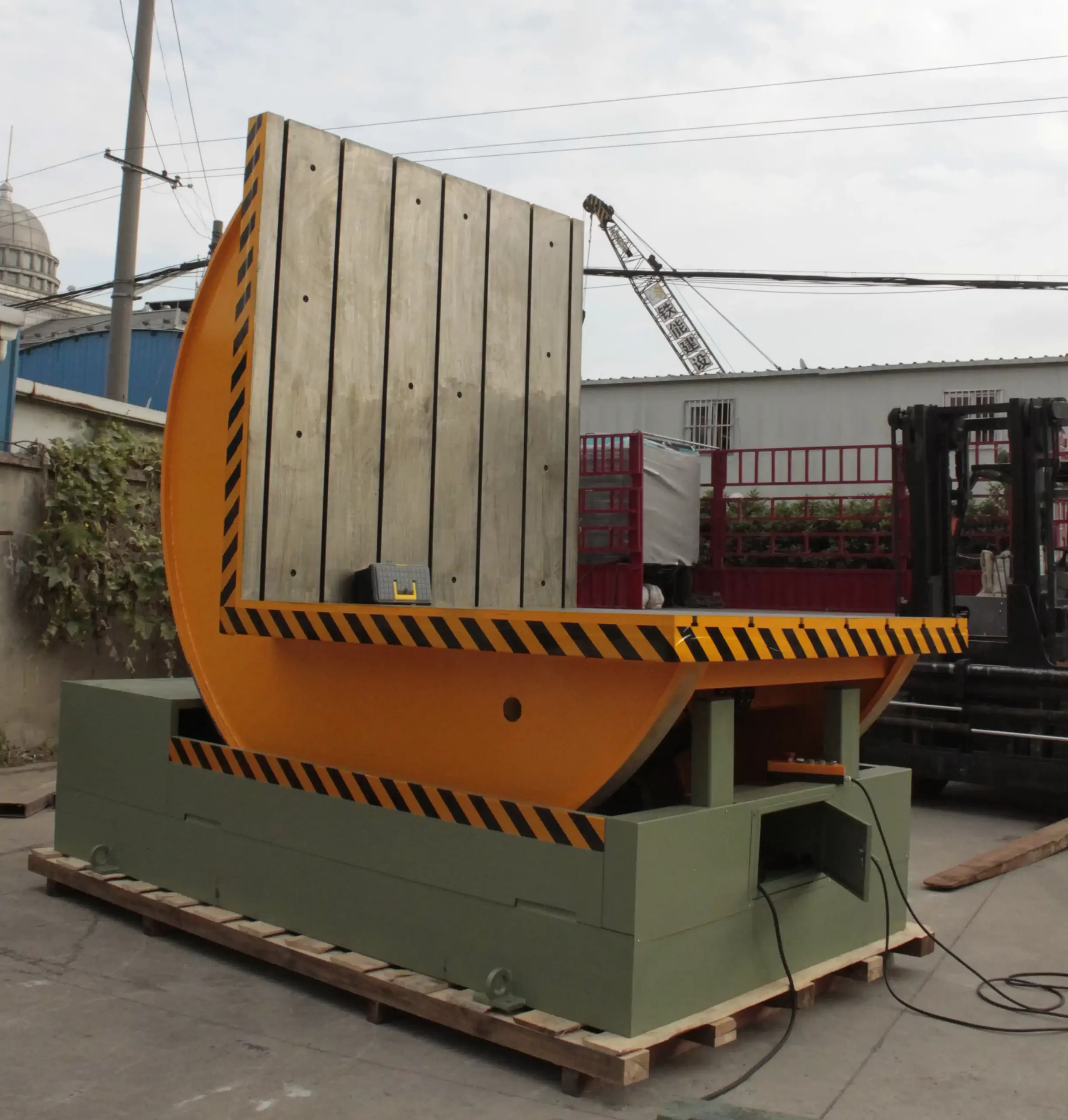Flipping heavy molds is a daily task in many factories. But it is also one of the most dangerous. I’ve seen it myself. A heavy steel mold, sometimes weighing many tons, hanging from a crane. The whole operation depends on the skill of the crane operator and the strength of the chains. A small mistake can lead to big problems. The mold can be damaged, costing thousands to repair or replace. Worse, someone could get seriously hurt. This constant risk creates stress and inefficiency. It ties up your most valuable lifting equipment and slows down production. But there is a much better way. It’s a method that is engineered for safety and transforms a high-risk task into a simple, controlled process.
Argentine factories can safely flip heavy molds and prevent damage by using a specialized mechanical mold upender, also known as a tilter. This machine securely holds the mold on a stable platform and uses a powerful drive system to provide a smooth, controlled 90-degree rotation. This process eliminates the dynamic risks and shock loading associated with using overhead cranes and temporary rigging for turning operations.

This might sound like just another piece of equipment. But I want to show you it's much more than that. I'm Vincent Liu, and I've spent my career in packing and material handling machinery. I started on the factory floor and eventually built my own company, SHJLPACK. I have seen how the right equipment can completely change a company's operations. The challenges you face in Argentina are very similar to what my clients in Mexico, Brazil, and around the world deal with. Let's dig deeper into why the old ways are so risky and how a modern solution provides a clear return on investment.
What Are the Hidden Dangers of Traditional Mold Flipping Methods?
You probably use an overhead crane to flip your molds. It seems logical because the crane is already there and can lift the weight. But you know this process is not perfect. It feels improvised and creates a sense of unease on the factory floor. Every time a mold is lifted and turned with slings and chains, you are taking a gamble. The center of gravity shifts. The load can swing. A sudden jolt can stress the crane and the mold itself. You are relying entirely on operator skill to prevent an accident. Understanding these specific dangers is the first step toward building a better, safer, and more productive process.
The hidden dangers of traditional mold flipping methods include damage to the mold's precision surfaces from impact, uncontrolled swinging that can harm nearby equipment, and shock loading that puts immense stress on crane components. These methods also create significant safety hazards for personnel from the potential of a dropped load or unpredictable movements during the turn.

Deeper Dive: Unpacking the True Costs of Crane Flipping
When I talk to factory owners, they often see crane flipping as a "free" operation because they already own the crane. But the hidden costs are substantial. Let's break them down into three key areas.
Risk to Equipment Integrity
An overhead crane is designed for vertical lifting. It is not designed for the complex, dynamic forces created when a heavy, asymmetrical object is tumbled in mid-air. This creates several problems. First, shock loading. When the mold is turned, it can jerk or drop slightly, sending a shockwave through the chains, the hook, and the crane's hoist and brake systems. This accelerates wear and tear, leading to more frequent maintenance and a higher risk of failure. Second, the mold itself is at risk. The chains or straps used for rigging concentrate massive forces on small areas of the mold. This can cause surface damage, warping, or even cracks over time, compromising the quality of your final product. A hard landing on the floor can easily damage a precision-machined surface, requiring costly repairs and downtime.
Personnel Safety Hazards
This is the most critical danger. When a multi-ton mold is suspended, the area beneath and around it is a no-go zone. But in a busy factory, people are always moving. A swinging load can be catastrophic. The biggest risk is equipment failure. I remember a story from an old colleague about a chain that snapped during a flip. Luckily, no one was underneath it, but the mold was destroyed. It was a wake-up call for the entire plant. Beyond catastrophic failure, there are ergonomic risks. Workers often have to manually guide the mold with push poles or ropes, putting them in awkward positions and close to a potentially unstable load. This is a recipe for an accident.
Operational Inefficiencies
This danger hits your bottom line directly. Flipping a mold with a crane is a slow, multi-person job. You need a certified crane operator and at least one or two riggers on the ground. The process can take 15 to 30 minutes from start to finish. While this is happening, your most valuable piece of material handling equipment—the overhead crane—is tied up. It cannot be used to load raw materials, move finished goods, or service production machines. This creates a major bottleneck that ripples through your entire operation, reducing overall plant efficiency and throughput.
| Metric | Traditional Crane Flipping | Dedicated Mold Upender |
|---|---|---|
| Safety | High risk of dropped loads & swings | Extremely high, load is contained |
| Personnel Required | 2-3 (Crane Operator, Riggers) | 1 (Machine Operator) |
| Cycle Time | 15-30 minutes | 1-3 minutes |
| Equipment Risk | High stress on crane, risk to mold | Negligible stress on mold and machine |
| Crane Availability | Crane is occupied during flip | Crane is free for other tasks |
How Does a Mechanical Mold Upender Improve Safety and Efficiency?
You see the problems with the old method. But changing a core process can seem like a major disruption. You might worry that a new machine is just another thing to maintain, another system to train people on. But what if a machine could actually simplify your workflow? What if it could remove a bottleneck and make your facility safer at the same time? That is exactly what a mechanical upender does. It is not just another machine. It is a purpose-built solution. It turns a complex and dangerous manual task into a simple, automated, and predictable action.
A mechanical mold upender improves safety by completely securing the mold on two solid platforms before the rotation begins. It uses a powerful but smooth electro-mechanical drive system to perform a controlled 90-degree rotation. This design eliminates any chance of the load swinging or dropping. It also improves efficiency by freeing up the overhead crane and reducing the labor needed for the task to a single operator.

Deeper Dive: The Engineering of a Safer Workflow
The beauty of a mold upender is its simplicity and robust design. As an engineer, I appreciate equipment that does one job and does it perfectly. Let's look at how its design directly solves the problems we've discussed.
The Engineering Behind the Safety
The core of the machine is a heavy-duty frame made from welded structural steel. This provides a massive, stable base that can easily handle the forces of rotation. The mold is placed on one of two platforms. For flat-bottomed molds, these are solid steel plates, often covered with a protective material like wood or polyurethane to prevent scratches. The mold rests securely on this platform. There is no swinging, no balancing act.
The rotation itself is driven by a powerful electric motor connected to a high-ratio gearbox. This gearbox turns a heavy-duty roller chain or a large slew bearing, which moves the rotating body of the machine. The key here is control. The movement is slow, smooth, and predictable every time. There is no jerking or shock loading. The center of gravity of the mold is always controlled and contained within the machine's footprint. It’s an engineered movement, not an improvised one.
Boosting Operational Efficiency
The impact on your factory's workflow is immediate. First, speed. A typical flip cycle with a mechanical upender takes about one to three minutes. Compare that to the 15-30 minutes required for a crane operation. This saved time adds up quickly over a week or a month. Second, labor. The process becomes a one-person job. A single operator can load the mold with a forklift or crane, press a button on a simple control pendant, and watch the machine do its work. You no longer need to coordinate a crane operator and riggers.
The biggest efficiency gain, and one that CEOs often appreciate most, is freeing up your overhead crane. In most factories I've visited, the crane is the hardest-working piece of equipment. When it's busy flipping molds, it's not feeding your production lines or loading trucks. By delegating the flipping task to a dedicated upender, you remove a major bottleneck. Your crane can now focus on value-adding tasks, directly contributing to higher plant throughput and better utilization of your assets.
What Key Features Should You Look For in a Mold Flipper?
Okay, you are interested in a mold upender. You see the benefits for safety and efficiency. But now you have a new challenge: choosing the right one. When you search online, many machines look similar. Salespeople will all promise their machine is the best. Making the wrong choice can be a costly mistake. You could buy an undersized machine that fails under load. You could get an over-engineered one that is too complex for your team to operate and maintain. Or you could buy one that lacks the critical safety features you need. This is a long-term investment. It needs to be the right one.
When choosing a mold flipper, you should look for key features like a certified load capacity that is at least 20% higher than your heaviest mold. You should also look for a reliable electro-mechanical drive system, comprehensive safety features like automatic limit switches and accessible emergency stops, and durable platform surfaces that protect your mold from damage.

Deeper Dive: An Engineer's Checklist for Buying an Upender
As someone who has designed, built, and commissioned these machines, I can tell you what really matters. I've created a simple checklist to guide you. It goes beyond the sales brochure and focuses on the engineering and practical details that ensure a reliable and safe machine.
Core Mechanical Specifications
This is the foundation of the machine. Get this wrong, and nothing else matters.
- Capacity: This is non-negotiable. Never buy a 20-ton upender to flip a 20-ton mold. Always insist on a safety margin of at least 20-25%. This accounts for uneven weight distribution and provides long-term durability. Ask the manufacturer for a certified load test report.
- Structure: Look closely at the construction. Is it a fully welded, heavy-gauge steel frame? I recommend welded frames over bolted ones because bolts can loosen over time due to vibration.
- Drive System: You will see two main types: hydraulic and electro-mechanical. While hydraulics can lift very heavy loads, I almost always recommend an electro-mechanical system for mold upenders. It's cleaner (no risk of oil leaks on your molds or floor), requires less maintenance, and provides a smoother, more consistent rotation. It is also more energy-efficient.
Control and Safety Systems
These features are what make the machine safe and easy to use.
- Controls: The control system should be simple. A handheld pendant with clear "Forward," "Reverse," and "Stop" buttons is usually best. It allows the operator to stand at a safe distance and have a clear view of the operation.
- Limit Switches: The machine must have automatic limit switches that stop the rotation precisely at 0 and 90 degrees. This prevents over-travel and ensures a consistent, safe operation every time.
- Emergency Stop: There should be multiple, easily accessible E-stop buttons on the machine and the control pendant.
Customization and Supplier Support
Every factory is different. A good supplier will work with you to provide the right machine.
- Platform Surface: The standard is a steel plate. But to protect your expensive molds from scratches, you should request a protective covering. Polyurethane pads are an excellent, durable option.
- Power and Integration: Ensure the supplier can build the machine to match your factory's electrical system (e.g., 380V/3Ph/50Hz in Argentina). If you want to integrate the upender into an automated line, discuss PLC integration options.
- Supplier Partnership: Don't just buy a machine. Buy a solution from a partner. Will they provide on-site installation support and training? What does their warranty cover? Do they have a good reputation? This support is just as important as the machine itself.
| Feature | Good (Minimum) | Better (Recommended) | Best (High-End) |
|---|---|---|---|
| Capacity | Matches max load | 20%+ safety margin | 25%+ margin with certified test |
| Drive System | Hydraulic | Electro-Mechanical (Chain) | Electro-Mechanical (Slew Drive) |
| Controls | Mounted Control Box | Handheld Pendant Control | Pendant + Wireless Remote |
| Safety | E-Stop only | E-Stop + Limit Switches | E-Stop, Limits + Safety Fencing |
| Platform | Bare Steel | Polyurethane or Wood Pads | Custom V-saddle or conveyor |
| Supplier | Sells the machine | Provides install & training | Full partnership & customization |
How Can a Mold Upender Impact Your Factory's Bottom Line?
A new machine is a capital investment. As a business owner, you must justify every dollar spent. The most important question is always: what is the return on this investment (ROI)? It is easy to look at a mold upender and see it only as a safety device. But that view is too narrow. It misses the powerful financial impact this machine can have. Its true value is measured in reduced operational costs, higher productivity, and the prevention of catastrophic expenses. This is about making your entire operation more profitable and competitive.
A mold upender directly impacts a factory's bottom line by lowering direct labor costs, increasing the productivity of your most critical assets like overhead cranes, and completely eliminating the risk of expensive mold damage during flipping. The ROI is often realized in less than two years through these combined operational savings and risk avoidance.

Deeper Dive: My Insights on the Financial Case
Over the years, I've helped many clients analyze this investment. The financial benefits are real and measurable. They align directly with the goals of any forward-thinking factory owner who wants to reduce costs and increase output. Let’s break down the ROI into concrete terms.
Direct Cost Reductions
This is the easiest part of the ROI to calculate.
- Labor Savings: Let's do some simple math. A crane flip needs 2-3 people for 20 minutes. An upender needs 1 person for 3 minutes. If you flip 5 molds per day, you save over 2 man-hours every single day. Over a year, that's hundreds of hours of labor that can be reallocated to more productive tasks.
- Maintenance Savings: By taking the stress of flipping away from your overhead crane, you reduce wear on its hoist, brakes, and cables. This means lower maintenance costs and longer life for your crane.
- Damage Prevention: This is the big one. A single accident that damages a complex mold can cost tens of thousands of dollars in repairs, not to mention the cost of lost production while it's being fixed. The cost to repair or replace just one mold can often be more than the cost of the upender itself. A mold upender is like an insurance policy that pays you back every day.
Boosting Productivity and Utilization
This is where the upender transforms from a cost-saver to a profit-driver.
- Unlocking Your Crane: In a steel mill or heavy manufacturing plant, the overhead crane is often the pacemaker. When it's busy, things move. When it's stuck doing an inefficient task like flipping a mold, the entire plant slows down. By giving this job to a dedicated machine, you free up your crane to do what it does best: move materials quickly. This single change can increase the overall throughput of your facility.
- Faster Changeovers: In a press shop, the time it takes to change a mold is pure downtime. A faster, safer flipping process is a key part of a quicker changeover. Shaving 15-20 minutes off every mold change means more uptime for your presses, which translates directly to more parts produced per shift.
A Strategic Investment
A mold upender is more than just a piece of equipment. It is a step toward a more modern, efficient, and safer factory. It demonstrates a commitment to operational excellence and employee safety. In today's competitive market, these are not small things. They are what separate the industry leaders from the rest. The financial case is clear. When you combine the direct cost savings with the productivity gains and the elimination of risk, the payback period for a mold upender is surprisingly short.
Conclusion
Investing in a mold upender is not just a safety upgrade. It is a strategic move for higher efficiency, lower costs, and a more robust and profitable production line.





